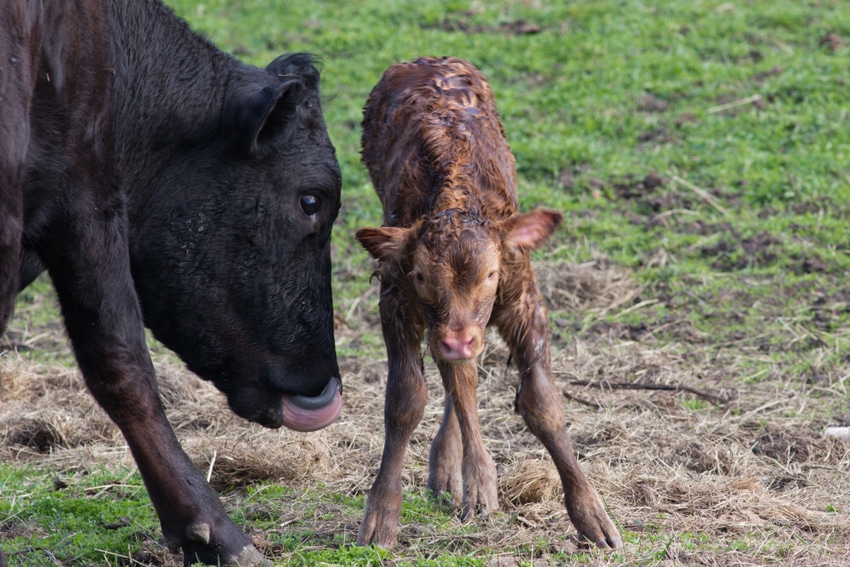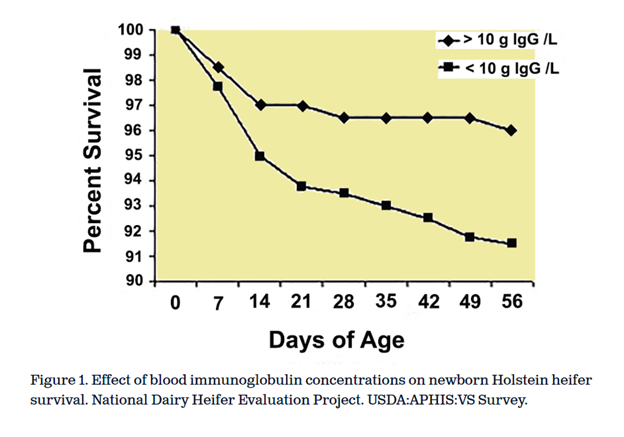Colostrum puts the best hoof forward
There is a short window for a calf to reap all the benefits of colostrum.
February 5, 2024

By Madison Kovarna, South Dakota State University Extension
Newborn calves have little to no immune system when they are born. One of the keys to starting a calf out on the right “hoof” following birth is ensuring that it has received colostrum in a timely manner. Colostrum is the first milk produced from a dam and is packed full of nutrients and antibodies. These antibodies are known as immunoglobins and are imperative for future calf health and survival. While in-utero, little to no placental transfer of immunoglobins occurs. Immunoglobin G (known as IgG) is the antibody that most people are familiar with, and it is extremely important in protecting the newborn calf. Figure 1 depicts the percent survival in calves with varying levels of circulating IgG. Calves that had greater than 10 grams of IgG per liter had increased survival rates compared to counterparts with levels lower than 10 grams of IgG per liter. Colostrum provides a safety net for the calf to utilize while jumpstarting their immune system.

Timing is critical
There is a short window for a calf to receive colostrum in order to reap all the benefits of this liquid gold. In newborn calves, the digestive system allows large molecules to pass through the tissue walls. Immunoglobins are extremely large molecules and rely almost completely on this trait of the newborn’s digestive system for absorption. In as little as 24 hours following birth, these openings that previously allowed immunoglobins to pass through the gut wall into the blood stream close. To receive as many benefits as possible, a calf should ingest 5-6% of its body weight (on average about two quarts) of colostrum within 4 hours, ideally within one hour of birth.
According to Mike Clawson, research molecular biologist at ARC Genetics, Breeding, and Animal Health Research Center, calves that do not receive colostrum are 50 times or more likely to die in the first 3 weeks of life.
Natural versus commercial sources
Natural colostrum taken from the cow should be a thick and creamy consistency with a yellowish color. Thin or pale colostrum may be of lower quality and not provide the calf with enough nutrients and antibodies for success. The best source of colostrum for a newborn calf is directly from its dam, but that is not always possible. Commercially made colostrum replacements and supplements are available to use when poor maternal instincts or a stressful birth prevent timely nursing.
Commercial colostrum sources are labeled as a “supplement” or as a “replacer.” Understanding the difference between the two is critical. The USDA Center for Veterinary Biologics regulates colostrum products that contain immunoglobulin (G, IgG). Whether a product is labeled as a supplement or replacement depends on its ability to raise blood concentrations of IgG. Replacers are able to raise blood concentrations above 10 milligrams per milliliter (10 grams per liter). Supplements are cheaper than most replacer products; however, they must be fed with additional colostrum from the cow. The levels of antibodies in supplements are lower (40 to 60 grams) as their intended use is in situations where inadequate quality and or quantity of colostrum was received by the calf. In the event where natural colostrum is completely unavailable, colostrum replacers should be utilized. When examining the label of a colostrum replacer product, ensure that it contains at least 100 grams of IgG. A calf should, at minimum, receive 100 grams of IgG, but to ensure adequate levels are available to the calf, it is recommended that the calf receives 150 to 200 grams of IgG in their first feeding. Additionally, follow mixing instructions closely to allow for maximum absorption by the calf.
Colostrum storage and thawing
It is possible for producers to collect and store colostrum from cows within their herd. Below is a checklist for dos and don’ts of colostrum storage and thawing.
Do
Chill colostrum immediately following collection.
Store in a refrigerator for less than 24 hours.
Freeze if wanting to store longer than 24 hours.
Double bag in plastic freezer bags.
Properly label and date storage bags (including cow number, date of collection, etcetera).
Don’t
Store at room temperature.
Store colostrum for longer than 1 year following collection.
Thaw colostrum in extremely hot water or microwave for longer than 1 minute at a time (this destroys the antibodies).
Reference: “A Guide to Colostrum and Colostrum Management for Dairy Calves” by Bovine Alliance on Management & Nutrition, 2001.
Cow’s impact on colostrum quality
Overall colostrum quality depends heavily on the cow and her nutrition, stress levels and overall health. Proper nutrition of your cow herd is extremely important when looking at colostrum quality. Late gestation nutrition has a large impact on quality of colostrum, as colostrum development begins 4 to 5 weeks prior to calving. This being said, following and implementing sound nutrition and vitamin and mineral plans that meet cattle requirements year-round is extremely important to prevent playing catch up or compromising herd health and performance.
Stress levels a cow will experience can ultimately impact her colostrum quality. In a stressed cow, nutrients that otherwise may be going to her colostrum supply are going to be used for her own benefit. This also applies if a cow develops an illness. Her colostrum quality may drop, because she is now utilizing those nutrients rather than storing them away for her calf. Cow age may also impact colostrum quality, with older cows producing better-quality colostrum compared to heifers. Additionally, these mature cows may produce colostrum at higher quantities.
In the end
Colostrum is extremely important to the newborn calf’s survival following birth. The immunoglobins and nutrients received from the first milk jumpstart the young calf’s immune system and start them out on the right “hoof.” Proper herd management through disease control, vaccination, and nutrition can help ensure that cows are producing high-quality colostrum.
You May Also Like


.png?width=300&auto=webp&quality=80&disable=upscale)
